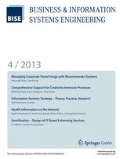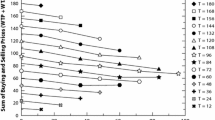Abstract
A key problem with IT decision-making is that the real value contributions of IT projects are unknown ex-ante to their executions. Thus, an organization has to rely on the expectations and perceptions of its decision makers. Moreover, these perceptions are prone to biases and display only a transfigured or irrational image of reality. This paper examines how these biases are related to the business value of IT (BVIT) and how IT decision-making can be rationalized. To this aim, a model is set up based on prospect theory, which is a frequently cited theory from behavioral economics used to descriptively analyze human value perception under risk. Applying the results found via prospect theory to IT decisions, the “perceived” BVIT is quantified and analyzed. Based on the model, the paper shows that the irrationalities rooted in human value perception provide explanations for two central paradoxes of IT. First, it reveals that they cause a disparity between the anticipated value-adding effects of IT and the actual measured outcomes, reflecting a famous observation within BVIT research known as the “productivity paradox of IT.” Second, recent studies show that IT increases the operational efficiency and competitiveness of organizations. However, only the operational effects are perceived in practice. In the paper, this one-sided perception is referred to as the “perception paradox of IT”. It is ultimately concluded that a rethinking of the position of IT within modern organizations and the establishment of suitable corporate governance mechanisms can resolve these issues, avoid irrationalities, and positively influence the performance impacts of IT.


Similar content being viewed by others
References
Anderson MC, Banker RD, Ravindran S (2003) The new productivity paradox. Commun ACM 46(3):91–94
Barney J (1991) Firm resources and sustained competitive advantage. J Manag 17(1):99–120
Bromiley P (1991) Testing a causal model of corporate risk taking and performance. Acad Manag J 34(1):37–59
Bromiley P (2009) A prospect theory model of resource allocation. Decis Anal 6(3):124–138
Brynjolfsson E (1993) The productivity paradox of information technology. Commun ACM 36(12):66–77
Brynjolfsson E, Hitt LM (1995) Information technology as a factor of production: the role of differences among firms. Econ Innovat New Tech 3(4):183–200
Cameron KS, Kim MU, Whetten DA (1987) Organizational effects of decline and turbulence. Admin Sci Q 32(2):222–240
Carr NG (2003) IT doesn’t matter. Harv Bus Rev 81(5):41–49
Chattopadhyay P, Glick WH, Huber GP (2001) Organizational actions in response to threats and opportunities. Acad Manag J 44(5):937–955
Cherry K (2013) The everything psychology book: explore the human psyche and understand why we do the things we do, 2nd edn. Adams Media, Massachusetts
David PA (1991) Computer and dynamo: the modern productivity paradox in a not-too distant mirror. In: OECD (ed) Technology and productivity: the challenge for economic policy. OECD, Paris, pp 315–348
De Giorgi E, Hens T (2006) Making prospect theory fit for finance. Financ Market Portfolio Manag 20(3):339–360
Denison EF (1989) Estimates of productivity change by industry: an evaluation and an alternative. The Brookings Institution, Washington, DC
Devaraj S, Kohli R (2003) Performance impacts of information technology: is actual usage the missing link? Manag Sci 49(3):273–289
Dewan S, Shi C, Gurbaxani V (2007) Investigating the risk-return relationship of information technology investment: firm-level empirical analysis. Manag Sci 53(12):1829–1842
Drucker PF (1966) The effective executive. Harper and Row, New York
Fiegenbaum A, Thomas H (1988) Attitudes toward risk and the risk–return paradox: prospect theory explanations. Acad Manag J 31(1):85–106
Fleischmann M, Amirpur M, Benlian A, Hess T (2014) Cognitive biases in information systems research: a scientometric analysis. In: Proceedings of the 22nd European Conference on Information Syststem, Tel Aviv, 9–11 June, pp 1–21
Fogelström ND, Barney S, Aurum A, Hederstierna A (2009) When product managers gamble with requirements: attitudes to value and risk. In: Glinz M, Heymans P (eds) Requirements engineering: foundation for software quality. Springer, Heidelberg, pp 1–15
Gartner (2013) Survey analysis: CFOs’ top imperatives from the 2013 Gartner FEI CFO technology study. http://www.financialexecutives.org/KenticoCMS/Research/FERF-Files/Survey-Analysis-CFOs-Top-Imperatives.aspx. Accessed 30 April 2014
Gilovich T, Griffin D, Kahneman A (2002) (eds) Heuristics and biases: the psychology of intuitive judgement. Cambridge University Press, Cambridge
Gonzalez R, Wu G (1999) On the shape of the probability weighting function. Cognit Psychol 38(1):129–166
Gurbaxani V, Melville N, Kraemer K (1998) Disaggregating the return on investment to IT capital. In: Proceedings of the 19th International Conference on Information Syststem, Helsinki, 13–16 December, pp 376–380
Henderson JC, Venkatraman N (1993) Strategic alignment: leveraging information technology for transforming organizations. IBM Syst J 32(1):4–16
Hirschheim R, Lacity M (2000) The myths and realities of information technology insourcing. Commun ACM 43(2):99–107
Hu Q, Quan J (2005) Evaluating the impact of IT investments on productivity: a causal analysis at industry level. Int J Inf Manag 25(1):39–53
Kahneman D, Tversky A (1979) Prospect theory: an analysis of decision under risk. Econometrica 47(2):263–291
Keil M, Mann J, Rai A (2000) Why software projects escalate: an empirical analysis and test of four theoretical models. MIS Q 24(4):631–664
Kohli R, Grover V (2008) Business value of IT: an essay on expanding research directions to keep up with the times. J Assoc Inf Syst 9(1):23–39
Kudyba S, Diwan R (2002) Research report: increasing returns to information technology. Inf Syst Res 13(1):104–111
Lee B, Menon NM (2000) Information technology value through different normative lenses. J Manag Inf Syst 16(4):99–120
Martin R (2007) The CIO dilemma. InformationWeek 131(1):38–44
Mata FJ, Fuerst WL, Barney B (1995) Information technology and sustained competitive advantage: a resource-based analysis. MIS Q 19(4):487–505
McAfee A (2009) Enterprise 2.0: new collaborative tools for your organization’s toughest challenges. Harvard Business Press, Boston
Melville N, Kraemer K, Gurbaxani V (2004) Review: information technology and organizational performance: an integrative model of IT business value. MIS Q 28(2):283–322
Nault BR, Dexter AS (1995) Added value and pricing with information technology. MIS Q 19(4):449–464
Oh W, Pinsonneault A (2007) On the assessment of the strategic value of information technologies: conceptual and analytical approaches. MIS Q 31(2):239–265
Papp R (1999) Business-IT alignment: productivity paradox payoff? Ind Manag Data Syst 99(8):367–373
Petter S, DeLone W, McLean ER (2013) Information systems success: the quest for the independent variables. J Manag Inf Syst 29(4):7–62
Santhanam R, Hartono E (2003) Issues in linking information technology capability to firm performance. MIS Q 27(1):125–153
Shimizu K (2007) Prospect theory, behavioral theory, and the threat-rigidity thesis: combinative effects on organizational decisions to divest formerly acquired units. Acad Manag J 50(6):1495–1514
Singh JV (1986) Performance, slack, and risk taking in organizational decision-making. Acad Manag J 29(3):562–585
Snow CP (1966) Government, science, and public policy. Sci 151(3711):650–653
Tallon P, Kraemer KL, Gurbaxani V (2001) Executives’ perceptions of the business value of information technology: a process-oriented approach. J Manag Inf Syst 16(4):145–173
Thatcher ME, Oliver JR (2001) The impact of technology investments on a firm’s production efficiency, product quality, and productivity. J Manag Inf Syst 18(2):17–46
Tversky A, Kahneman D (1981) The framing of decisions and the psychology of choice. Science 211(4481):453–458
Tversky A, Kahneman D (1992) Advances in prospect theory: cumulative representation of uncertainty. J Risk Uncertain 5(4):297–323
Weill P, Vitale M (1999) Assessing the health of an information systems applications portfolio: an example from process manufacturing. MIS Q 23(4):601–624
Wen Y (2010) Capital investment decision, corporate governance, and prospect theory. Procedia Soc Behav Sci 5:116–126
Wu W, Lin B, Cheng C (2009) Evaluating online auction strategy: a theoretical model and empirical exploration. J Comput Inf Syst 49(3):22–30
Yorukoglu M (1998) The information technology productivity paradox. Rev Econ Dynam 1(2):551–592
Author information
Authors and Affiliations
Corresponding author
Additional information
Accepted after two revisions by the editors of the special issue.
Electronic supplementary material
Below is the link to the electronic supplementary material.
Rights and permissions
About this article
Cite this article
Afflerbach, P. The Business Value of IT in Light of Prospect Theory. Bus Inf Syst Eng 57, 299–310 (2015). https://doi.org/10.1007/s12599-015-0400-6
Received:
Accepted:
Published:
Issue Date:
DOI: https://doi.org/10.1007/s12599-015-0400-6




